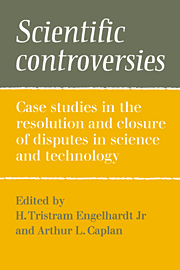 Scientific Controversies
Scientific Controversies Published online by Cambridge University Press: 03 February 2010
In writing constitutions and framing governments, the authors focus on the structure of governments (i.e., which institutions and offices of government will be formed), the powers assigned to those who will govern, the limits to be placed on rulers, and rules or criteria for reaching official decisions (e.g., that the “majority rules,” or that a presidential veto of a congressional action will stand unless two-thirds of the Congress votes to override the veto).
In the United States, particular attention has been paid to the rules for reaching official decisions. These rules have been a topic of debate or discussion since the original debates over the U.S. Constitution. In characterizing the traditions of American liberty, John P. Roche notes:
First … there is … the proposition that when all the fighting is over and all the pluralities have had their licks, a public policy which incorporates “justice and the general good” will emerge. Taken for granted here is a willingness on the part of all participants to play by the rules. A faction may disagree about substantive matters – about the content of particular items of policy – but it will not overturn the cardtable and shoot the other players. In short, there will be procedural consensus. (Roche, 1967)
These rules of decision making providing for “procedural consensus” are not designed to dictate specific substantive outcomes; instead, they are meant to formulate a process that will ensure fair, equitable, and “democratic” outcomes.
The process specifies the mechanisms that will be employed by political and organizational actors in their official interactions.
To save this book to your Kindle, first ensure [email protected] is added to your Approved Personal Document E-mail List under your Personal Document Settings on the Manage Your Content and Devices page of your Amazon account. Then enter the ‘name’ part of your Kindle email address below. Find out more about saving to your Kindle.
Note you can select to save to either the @free.kindle.com or @kindle.com variations. ‘@free.kindle.com’ emails are free but can only be saved to your device when it is connected to wi-fi. ‘@kindle.com’ emails can be delivered even when you are not connected to wi-fi, but note that service fees apply.
Find out more about the Kindle Personal Document Service.
To save content items to your account, please confirm that you agree to abide by our usage policies. If this is the first time you use this feature, you will be asked to authorise Cambridge Core to connect with your account. Find out more about saving content to Dropbox.
To save content items to your account, please confirm that you agree to abide by our usage policies. If this is the first time you use this feature, you will be asked to authorise Cambridge Core to connect with your account. Find out more about saving content to Google Drive.